A new entry in the River City (aka Kunio-Kun) franchise arrived last week on PC, Xbox One, PlayStation 4, and Nintendo Switch. River City Girls puts players into the shoes of Kyoko and Misako - the girlfriends of the usual series' protagonists, Kunio and Riki - as they attempt to track down whoever kidnapped their boyfriends and curb stomp them into oblivion. We spoke with the game's developer, WayForward, about this new entry in a series, how they approached the co-op aspects, and more!
Co-Optimus: Thanks for taking the time to talk with us today! First, could you introduce yourself, your role in the development of River City Girls, and a brief breakdown of what River City Girls is all about?
Adam Tierney: Hey there! I’m Adam Tierney, the writer and director of River City Girls. I’ve been directing games at WayForward for 15 years, and I’m also now the business development manager here, which means I pursue games and brands we’d like to work on (like River City)!
River City Girls is an original entry in the Kunio-kun/River City series that follows two of the series’s female protagonists (Misako and Kyoko) as they scour the city in search of their kidnapped boyfriends (Kunio and Riki), who are typically the main playable characters.
Co-Optimus: The Kunio-kun series has a very long and storied history in Japan (including a number of games that are not beat 'em ups), but here in the States perhaps the most well-known entry is River City Ransom, which was released 30 years ago on the NES. Looking back at that game it had a lot of features that, today, feel very commonplace: open-world/non-linear gameplay with character progression via stats and new moves. How did you want to bring those ideas into a modern entry? Was there anything you thought needed to be changed or improved?
Adam: Yeah, we dove into production on this title with 30 years and 50 Kunio-kun games to pull from — no pressure or anything!
I would say our four biggest points of influence for this title were: River City Ransom (the third game in the Kunio-kun series, and the one most US gamers are familiar with), Shin Nekketsu Koha: Kunio-tachi no Banka (the Super Famicom game that introduced Misako and Kyoko as playable badasses), River City Ransom: Underground (the Kickstarter-funded PC game directed by Bannon Rudis, who would design the combat on Girls), and Double Dragon II: The Revenge (the Kunio-kun and Double Dragon worlds, characters, and combat have been crossing over with one another for a long time). So those four games made up the DNA of this one.
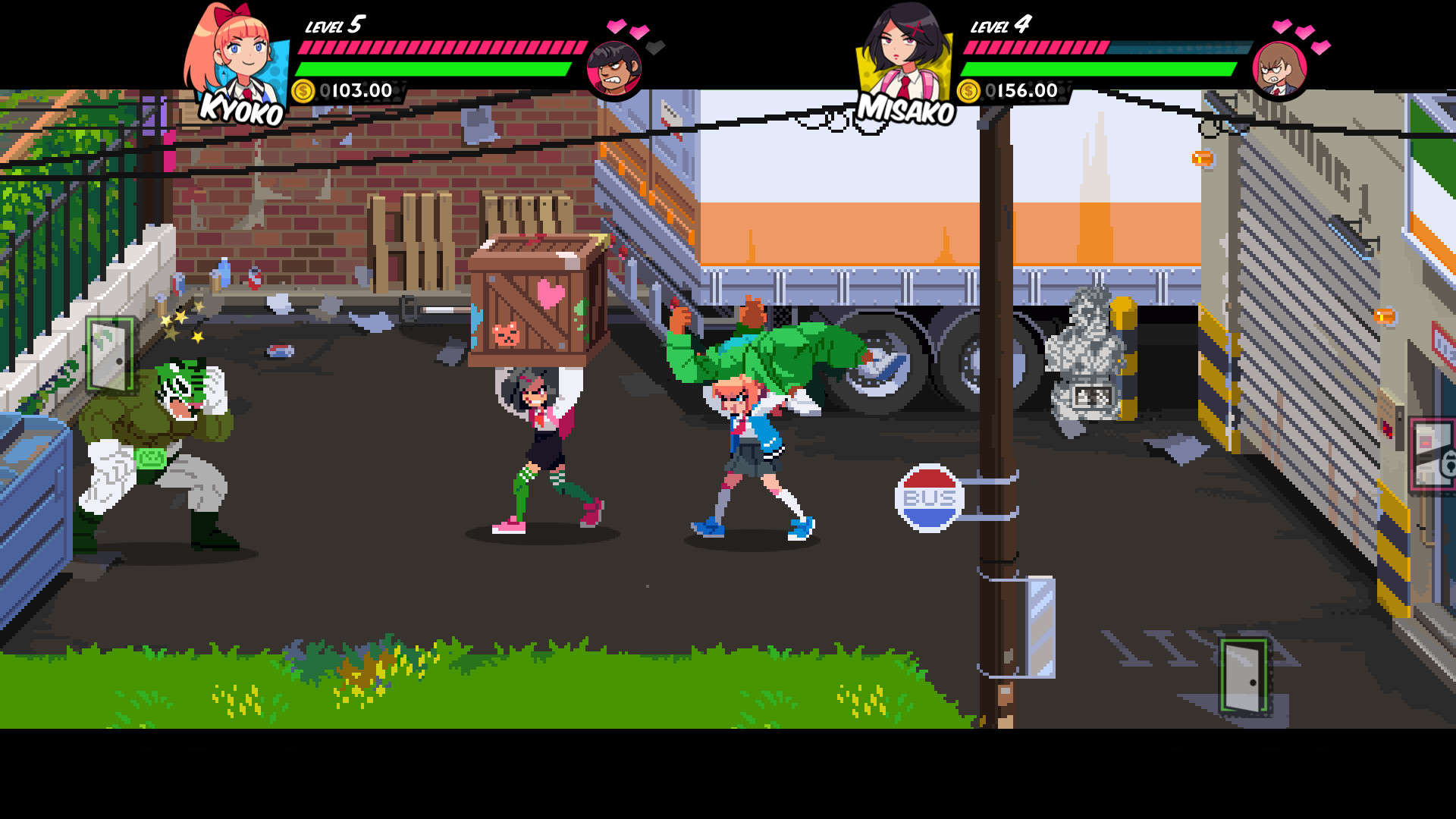
As far as deciding what to do and not do in this game, we didn’t just rehash the elements from those four games; we went in with a very specific vision for this game. We wanted the game to be easy for beginners to get into, while retaining enough depth to appeal to hardcore brawler fans. So the button inputs in the game — much like Super Smash Bros. or Dragon Ball FighterZ — are rarely more complex than pressing a direction plus a button. If a player decides to pull off a move, we want them to be able to reliably pull off that move, not struggle with the controls. I think that simple-input approach is becoming more commonplace in fighters and brawlers, so that could be seen as one way we updated the formula.
Another is in the world creation. It’s easy to get burned out in brawlers because it may feel like you’re doing the same thing over and over, fighting through the same back alley endlessly. And that was due in large part to the limited BG tile resources of old-school NES, SNES, and arcade games. But we wanted our world to feel alive and vast. So the 80 or so locations in this game are all completely unique. We don’t use tilesets in this game; instead, Bannon would create a basic layout of each location, and then our team of incredibly talented BG artists would dress those scenes with pixel art. The end result is that every scene bring news visuals you haven’t previously encountered, and River City feels like a genuine place, rather than a collection of samey tiled locations.
Our storytelling is also dense and funny. This game is all about Misako and Kyoko on their journey to find and rescue their boyfriends, so there’s a lot of VO-driven storytelling through passive dialog (which plays over combat), anime scenes, manga scenes, slide-in portraits (Shantae-style), and other systems, including the classic enemy-death lines (BARF!) We wanted gamers to fall in love with these goofy (in our interpretation) characters, so you’re constantly hearing from them. At the same time, we didn’t want to have all that story at the expense of gameplay, so all VO and storytelling scenes either play during combat or are skippable.
And finally, the visuals got a pretty big overhaul, which is significant because most of the 50 previous Kunio-kun games have characters that look pretty identical to the sprites in River City Ransom. As much as we love those blocky-headed character designs, it was important that River City Girls had its own visual identity. So our sprites are designed in a way that’s unlike any previous Kunio-kun games, and also unlike any previous WayForward games.

Co-Optimus: In another interview you mentioned that there's a lot of "metroidvania" DNA in River City Ransom and River City Girls, and that for River City Girls players can go back to previous chapters/areas of the game. Are there moves or abilities you unlock as you play that let you access certain places you couldn't reach before?
Adam: You do open up new locations in previously-completed worlds, but this is always driven by items you collect (like keys or macguffins that characters are looking for) or by story moments (like NPCs clearing a path for you). There are a few spots in the game where you have to carefully navigate to get through a tricky path — in particular, one very silly, inspired scene in the second area that Bannon came up with — but we didn’t want to lean on those elements as regularly as in a Metroid or Castlevania game. That said, there are hidden objects throughout the game that you must collect as an optional side-quest, and reaching some of those can involve some tricky parkour moves.
Co-Optimus: You mentioned before that River City Girls draws inspiration from the Japan-only Shin Nekketsu Koha: Kunio-tachi no Banka on the Super Famicom, which featured Misako and Kyoko as playable characters. What were some of the specific features of that game (aside from the characters) that you wanted to bring into River City Girls?
Adam: Shin Nekketsu Koha: Kunio-tachi no Banka is just a very different type of Kunio-kun game, compared to something like Renegade (first game) or River City Ransom (third game). The base combat is similar, but then you have lots of contextual combat like curb-stomping enemies while they lie on the ground. Speaking of that move, seeing Misako and Kyoko’s curb stomp in that game is what initially got me excited to revisit those characters. Shin Nekketsu Koha: Kunio-tachi no Banka was also, comparatively, very story and dialog-heavy compared to other Kunio-kun games. Although that game is a little more tough and aggressive, compared to our lighter and funnier tone in River City Girls, there’s still a similar feel in how the story unfolds between the two games.
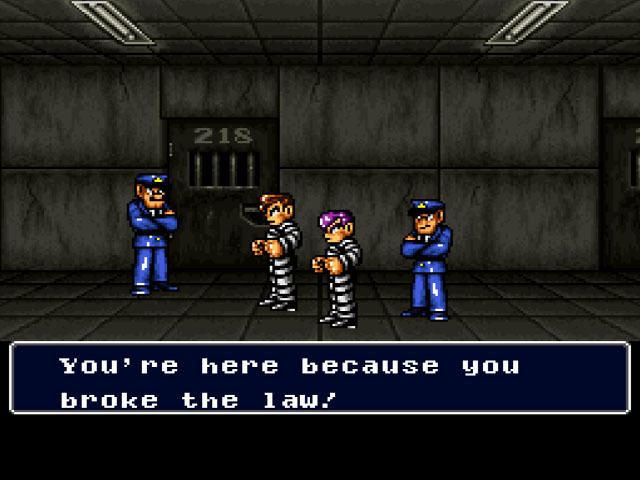
Co-Optimus: One feature that both Shin Nekketsu Koha: Kunio-tachi no Banka and River City Ransom have in common that we love is co-op. When developing River City Girls, what was first in your mind for designing the "co-op experience?" What did you know you had to get right and what did you want to improve from the past games? Are there any "combo moves"? Also, I understand there's a unique revive mechanic...
Adam: The most important, I think, is providing players with opportunities to coordinate or interact with one another. While there are no literal, arcade-Simpsons-esque tag-team moves in this game, the moves were designed to juggle and knock enemies around in a way that a combo could be started with one player, then handed off to the other character to finish. For example, Kyoko might hit an enemy with her dodgeball-save move, knocking them up into the air, for Misako to then grab and slam back down to earth. If we get to do any Kunio-kun DLC or sequel releases in the future, I think adding in specific character-combination attacks would be one of the first things we’d investigate. But for this first game, any “combo moves” are organic by choosing attacks that will set the other player up to finish an enemy or boss.
There’s also a big focus on protecting or saving one another in a two-player game. The relationship between Misako and Kyoko is at the heart of the game -- even as they search for their boyfriends, the friendship between these two girls is so much stronger than any romance they’re a part of. So we looked for ways to reinforce this close friendship, in story and in gameplay mechanics. For example, when one player dies in a multiplayer game, their character’s soul rises up from their body. If the other player can rush over in time and begin stomping their friend’s corpse, they can stuff their soul back into their body and give the other player another chance at continuing. So little things like that, or making bosses and enemies attack in a way that the other player can swoop in to save or defend their friend, was key to the game’s design.
Co-Optimus: What was one of the biggest challenges when designing co-op in a modern "River City" game?
Adam: It can be tough to find a good balance in difficulty and enemy AI between one- and two-player modes, and also normal vs. hard difficulty settings. That requires a lot of balancing and tweaking.
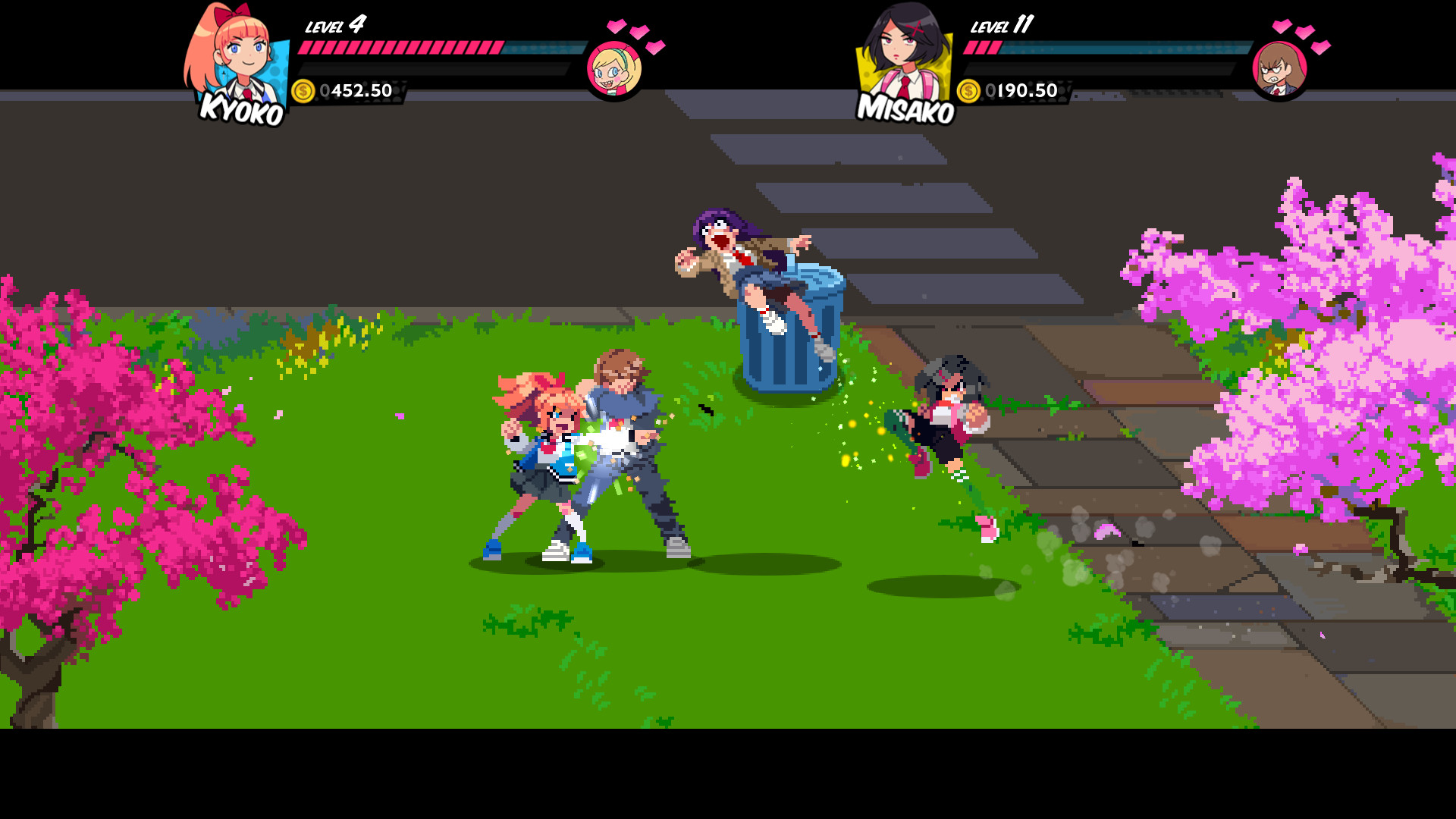
More challenging, I think, was just the vast amount of systems we wanted to include in the game. People forget how much gameplay is under the hood in a typical Kunio-kun game — story, stats, levels, quests, items, etc. And we added even more systems to this game, such as the accessories and recruits systems. You don’t have to deal with most of those systems in a typical brawler, so the biggest challenge was definitely the sheer number of gameplay and storytelling systems we had to include, and then refining those to all feel polished and engaging.
Co-Optimus: I noticed in gameplay footage that each player is picking up their own money from fallen enemies and earning their own experience (i.e., nothing is shared). Is there an option to split things evenly between players, and, if not, why keep these things separate?
Adam: It’s a bit of both. At this point, I think the secret’s pretty much out that you can also play as the boyfriends, Kunio and Riki (though I won’t spoil here how to unlock them). So there are four very unique characters to level up and unlock and learn all their attacks. What we decided on was saving progress per save file (three files available) and then per character under each save file. Doing this would give players the opportunity to level up each character and learn their new attacks as they’re unlocked, as opposed to beating the game with Misako and then just having this uber-Kyoko already developed before you even play her. It also allowed us to maintain a consistent system for the boys, because you can’t unlock them at the game’s start. Finally, it provides players with one more thing to do in the game — you’ve got a level 30 (max) Misako? Now you can go develop Kyoko, Kunio, or Riki.
At the same time, we realized that leaving the other player completely unleveled would make them basically a punching bag if a second player wants to hop in late into a previously single-player game. So I think the compromise we settled on was that boss battles (those big game milestones) would split EXP between the two characters, but standard enemies only yielded EXP to the player who defeated them.
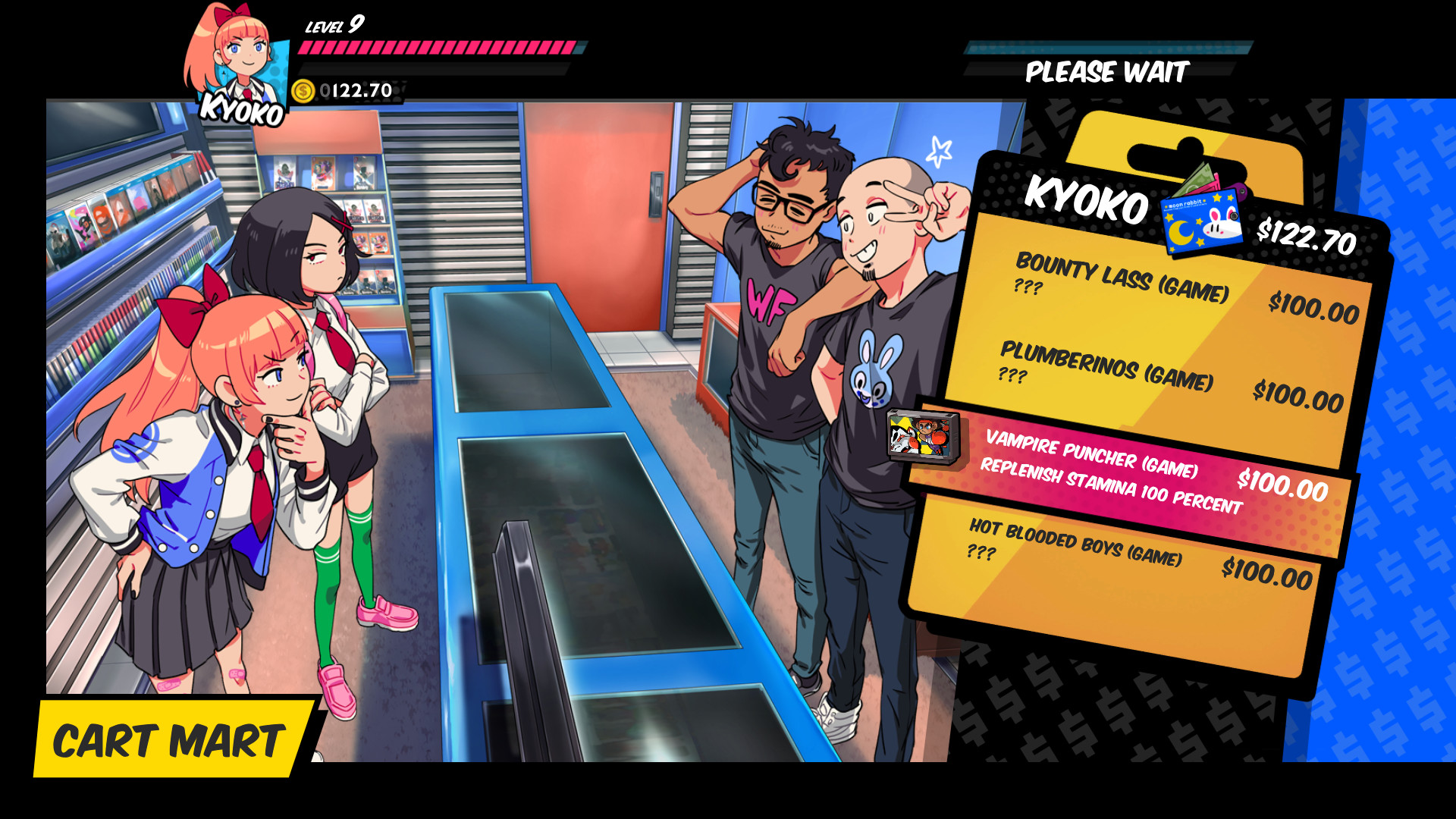
And as far as money, it’s split because all items and moves are separate between the two players. Even in the shops, the player who entered makes their purchases, then the other player makes theirs. So it made sense to keep wallets separate rather than pooled together.
Co-Optimus: Does this also extend to other features like the accessories and recruits? Are those acquired per player, or if one player gets an accessory/recruit, can both players can use it?
Adam: Accessories are mostly shared, and that’s because you tend to earn those by defeating bosses and completing quests, rather than making shop purchases. I say mostly because we start each character off with 1 unique accessory in their inventory (to learn the system), and the other player can find and purchase that accessory later on if they wish.
Recruits are completely separate by character. Each player decides whether or not to recruit a begging enemy, which will remain with that player until the recruit is defeated, the character is defeated, or the player swaps in another recruit to replace them. For readers unfamiliar with the recruit system, it’s one of the coolest additions in this game. Basically, when only one enemy is left onscreen, and their health gets below a certain amount, they may beg for their life. When this happens, they can either be beaten up, or either player can grab and spare (recruit) them, which converts the enemy into a Marvel vs. Capcom-style jump-in assist attack. Any non-boss enemy in the game can be recruited. We even have a Pokedex-style profile database for recruited enemies, which encourages players to recruit all 50+ variations in the game.
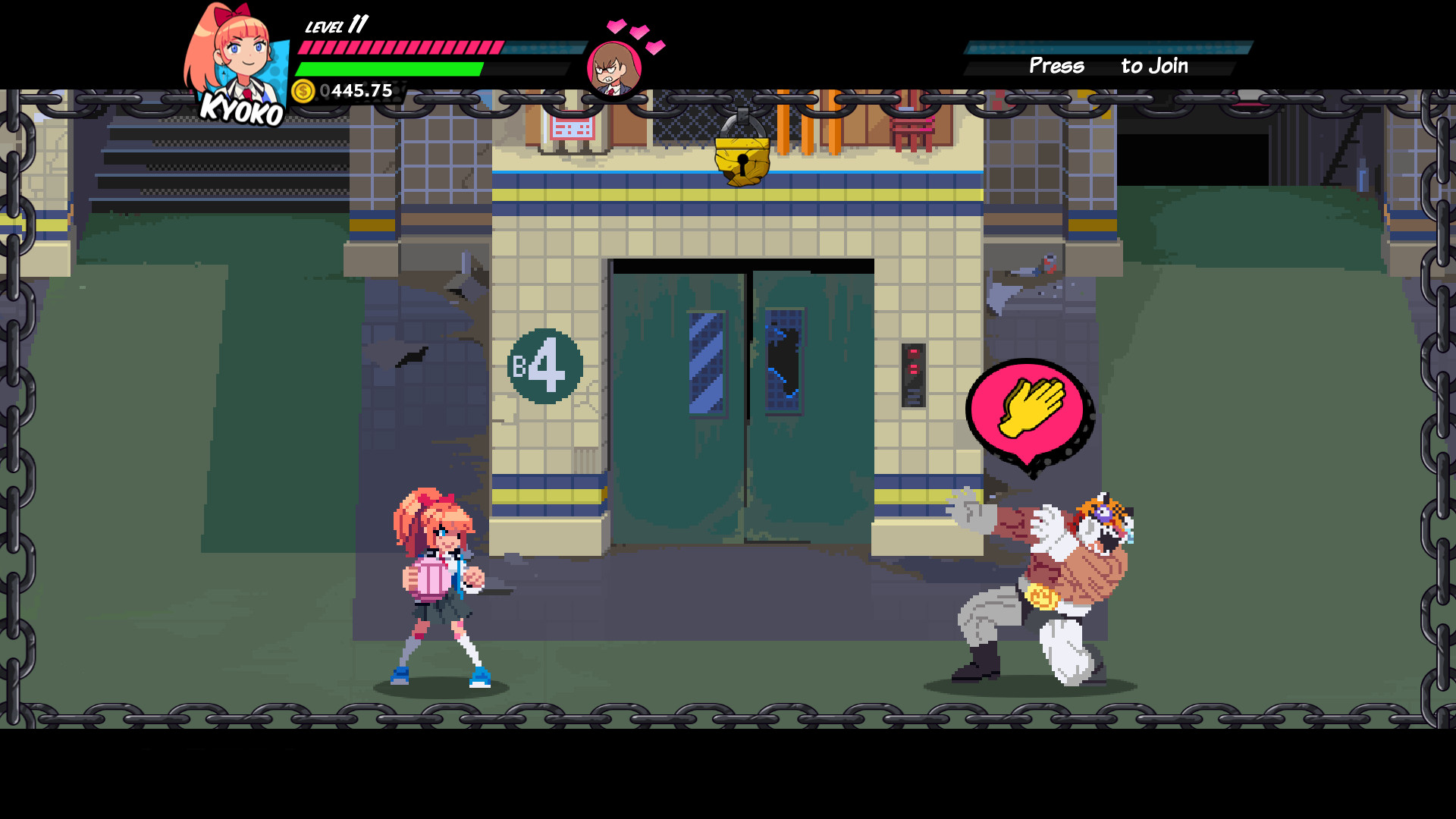
Co-Optimus: I read that online co-op was a feature you just couldn't work into the game this time around. Is that anything that could be implemented later as a post-launch update, or would too many changes have to be made to the game itself?
Adam: It’s possible, but since so many of the game’s systems work on the logic of it being local multiplayer, it might take a significant effort for a less-than-ideal experience. I think it’s definitely something we’d like to consider for future River City games, though, if we’re fortunate enough to get another stab at this brand, now that we’ve already got a solid foundation established with all the other gameplay systems.
Co-Optimus: Finally, what's one feature of the game that you feel really shines in co-op and you can't wait for folks to experience?
Adam: Not to be a broken record, but it’s definitely the revive mechanic. Watching players discover and use that at live demos made it clear people really love the system, both for its absurdity and how it gets players working together. And I’ve noticed that once players use that system, it also makes them just generally play with more consideration and awareness of the other player, which is a cool side-effect.
Our thanks to WayForward and Adam Tierney for taking the time to answer our questions! River City Girls is available now on the PC, Xbox One, PlayStation 4, and Nintendo Switch. Two player drop-in/drop-out couch co-op is supported throughout the campaign.
